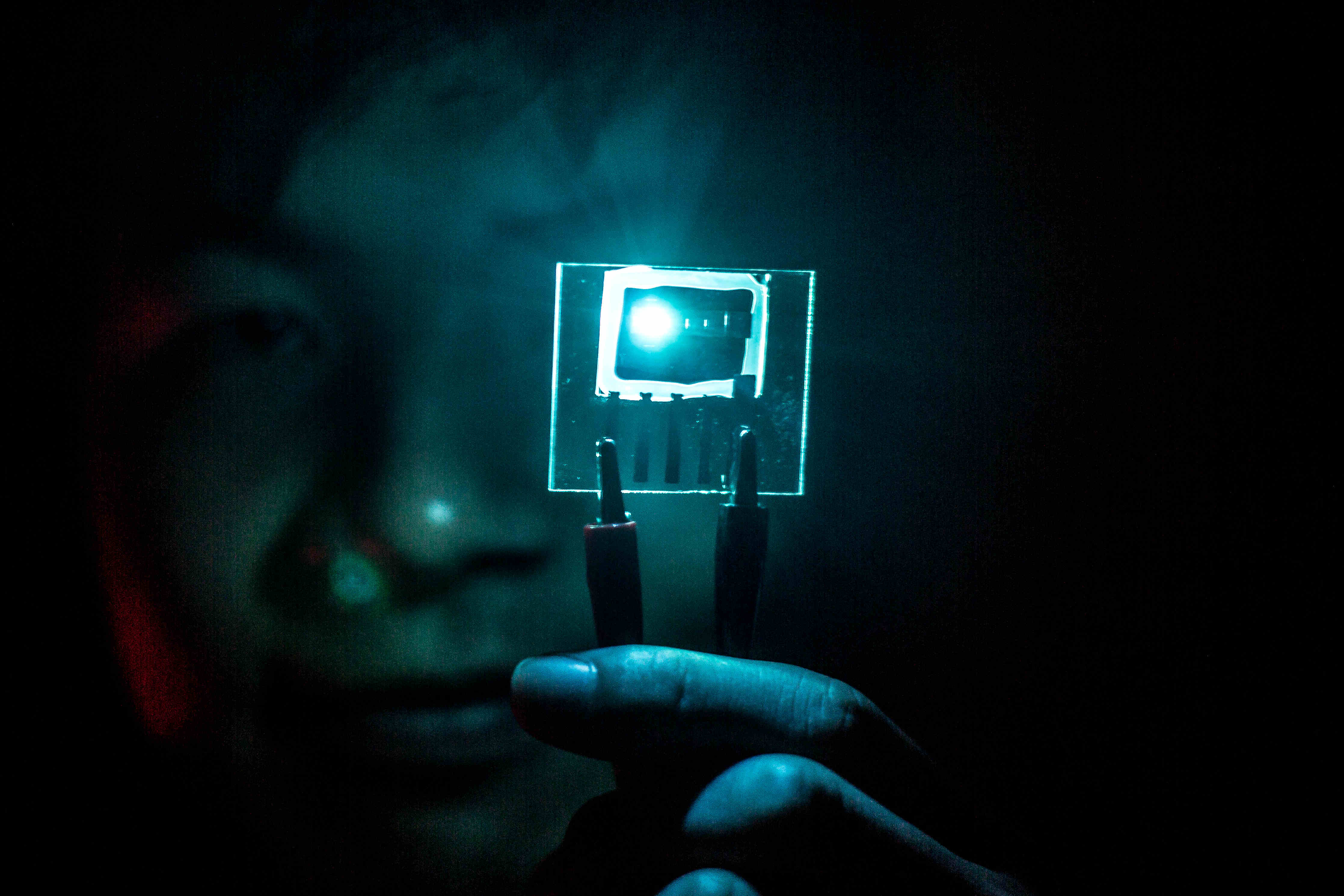Live long and phosphor: Blue LED breakthrough for efficient electronics
Researchers at the University have extended the lifetime of blue organic light emitting diodes by a factor of ten.

 Enlarge
Enlarge
ANN ARBOR- In a step that could lead to longer battery life in smartphones and lower power consumption for large-screen televisions, researchers at the University of Michigan have extended the lifetime of blue organic light emitting diodes by a factor of 10.
Blue OLEDs are one of a trio of colors used in OLED displays such as smartphone screens and high-end TVs. The improvement means that the efficiencies of blue OLEDs in these devices could jump from about 5 percent to 20 percent or better in the near future.









OLEDs are the latest and greatest in television technology, allowing screens to be extremely thin and even curved, with little blurring of moving objects and a wider range of viewing angles. In these “RGB” displays, each pixel contains red, green and blue modules that shine at different relative brightness to produce any color desired.
But not all OLEDs are created equal. Phosphorescent OLEDs, also known as PHOLEDs, produce light through a mechanism that is four times more efficient than fluorescent OLEDs. Green and red PHOLEDs are already used in these new TVs—as well as in Samsung and LG smartphones—but the blues are fluorescent.
“Having a blue phosphorescent pixel is an important challenge, but they haven’t lived long enough,” said Stephen Forrest, the Paul G. Goebel Professor of Engineering.
He and his colleagues demonstrated the first PHOLED in 1998 and the first blue PHOLED in 2001.
Now, with their new results, Forrest and his team hope that is about to change. Efficient blues will make a significant dent in power consumption for large-screen TVs and extend battery life in smartphones.
The lifetime improvement will also help prevent blue from dimming relative to red and green over time.
“In a display, it would be very noticeable to your eye,” Forrest said.
In collaboration with researchers at Universal Display Corp. in 2008, Forrest’s group proposed an explanation for why blue PHOLEDs’ lives are short. The team showed that the high energies required to produce blue light are more damaging when the brightness is increased to levels needed for displays or lighting.
This is because a concentration of energy on one molecule can combine with that on a neighbor, and the total energy is enough to break up one of the molecules. It’s less of a problem in green- and red-emitting PHOLEDs because it takes lower energies to make these colors of light.
“That early work showed why the blue PHOLED lifetime is short, but it didn’t provide a viable strategy for increasing the lifetime,” said Yifan Zhang, a recent graduate from Forrest’s group who is first author on the new study. “We tried to use this understanding to design a new type of blue PHOLED.”
The solution, demonstrated by Zhang and Jae Sang Lee, a current doctoral student in Forrest’s group, spreads out the light-producing energy so that molecules aren’t as likely to experience the bad synergy that destroys them.
The blue PHOLED consisted of a thin film of light-emitting material sandwiched between two conductive layers—one for electrons and one for holes, the positively charged spaces that represent the absence of an electron. Light is produced when electrons and holes meet on the light-emitting molecules.
If the light-emitting molecules are evenly distributed, the energetic electron-hole pairs tend to accumulate near the layer that conducts electrons, causing damaging energy transfers. Instead, the team arranged the molecules so that they were concentrated near the hole-conducting layer and sparser toward the electron conductor. This drew electrons further into the material, spreading out the energy.
The new distribution alone extended the lifetime of the blue PHOLED by three times. Then, the team split their design into two layers, halving the concentration of light-emitting molecules in each layer. This configuration increased the lifetime tenfold.
“Our university research programs are a strong element of our effort towards solving critical OLED issues and accelerating the growth of the display and lighting industries,” said Julie Brown, senior vice president and chief technical officer of Universal Display. “This exciting result by Professor Forrest and his team is an important step towards a full commercial phosphorescent RGB solution.”
This research is described in a study titled “Ten-Fold Increase in the Lifetime of Blue Phosphorescent Organic Light Emitting Diodes,” appearing in Nature Communications. Forrest is also a professor of electrical engineering, physics, and materials science and engineering. The work was supported and is licensed for commercialization by Universal Display.
Additional Info
Stephen Forrest, Paul G. Goebel Professor of Engineering
“Tenfold increase in the lifetime of bluephosphorescent organic light-emitting diodes,” Yifan Zhang, Jaesang Lee, Stephen R. Forrest, Nature Communications, 2014 25;5:5008. Epub 2014 Sep 25.
In the News
IEEE Spectrum – Long-Lived Blue OLED Could Lead to Better Displays (9/25/14)
Seeking Alpha – What Does This Recent Blue PHOLED Breakthrough Mean For Universal Display? (9/26/14)
NDTV Gadgets (9/26/14)
Environmental News Bits (9/26/14)
Photonics.com – Advances in Blue OLEDs Increase Efficiency and Lifetime (9/25/14)
Oled-info.com – Blue PHOLED breakthrough: researchers manage to extend the lifetime tenfold (9/25/14)
Michigan Daily – Molecular developments to allow for more efficient electronic displays
U-M Press Release (9/25/14)
 MENU
MENU 
